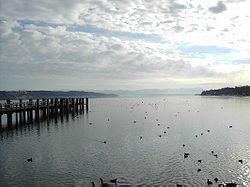Starnberger See
| Lake Starnberg | |
|---|---|

|
|
| Location | Bavaria |
| Coordinates | 47°54′14″N 11°18′26″E / 47.90389°N 11.30722°ECoordinates: 47°54′14″N 11°18′26″E / 47.90389°N 11.30722°E |
| Type | Natural lake |
| Primary inflows | Steinbach or Ostersee-Ach |
| Primary outflows | Würm |
| Catchment area | 314 km2 (121 sq mi) |
| Basin countries | Germany |
| Max. length | 20.2 km (12.6 mi) |
| Surface area | 58.36 km2 (22.53 sq mi) |
| Max. depth | 127.8 m (419 ft) |
| Water volume | 2,998×106 m3 (105.9×109 cu ft) |
| Residence time | 21 years |
| Surface elevation | 596 m (1,955 ft) |
| Islands | Roseninsel |
| Settlements | Starnberg, Ammerland, Seeshaupt, Tutzing, Feldafing, Possenhofen |
Lake Starnberg (German: Starnberger See) — called Lake Würm (German Würmsee) until 1962, and also known as Fürstensee — is Germany's fifth largest freshwater lake in terms of area and, due to its great average depth, the second largest in terms of water volume. The lake and its surroundings are an unincorporated area within the rural district of Starnberg; the lake itself is the property of the state of Bavaria and is administered by the Bavarian Administration of State-Owned Palaces, Gardens and Lakes.
Located in southern Bavaria 25 kilometres (16 mi) southwest of Munich, Lake Starnberg is a popular recreation area for the city and, since 1976, one of the wetlands of international importance protected by the Ramsar Convention. The small town of Berg is famous as the site where King Ludwig II of Bavaria was found dead in the lake in 1886. Because of its associations with the Wittelsbach royal family, the lake is also known as Fürstensee (Prince's Lake). It is also mentioned in T. S. Eliot's poem The Waste Land.
The lake, lying in a zungenbecken or glacial hollow, was created by ice age glaciers from the Alps, and extends 21 km (13 mi) from north to south and has a width of 3–5 km (2-3.5 miles) from east to west. It has a single small island, the Roseninsel, and a single outlet, the Würm river (because of this river the lake was called the Würmsee until 1962). Its major inflow comes from a small river called the Steinbach or Ostersee-Ach, which flows through a chain of small lakes to the south, the Osterseen. The lake's water is of excellent quality due to the introduction in the 1960s of a circular sewerage system which collects wastewater from the settlements around the lake and transports it to a treatment plant below the lake's outlet at Starnberg. Bronze fish-hooks and a dugout dating to the 9th or 8th century BCE have been discovered at the lake, and there are still some professional fishers, most of them continuing a family tradition.
...
Wikipedia
